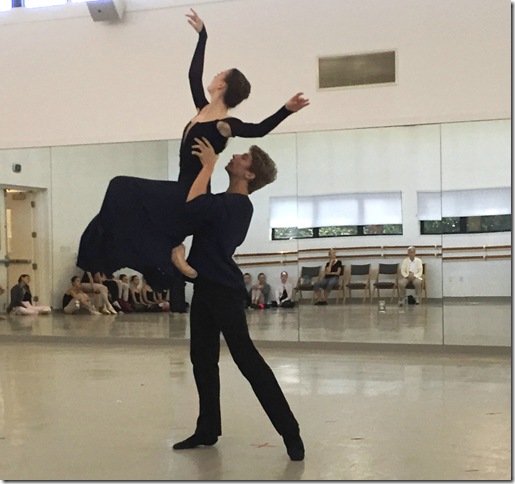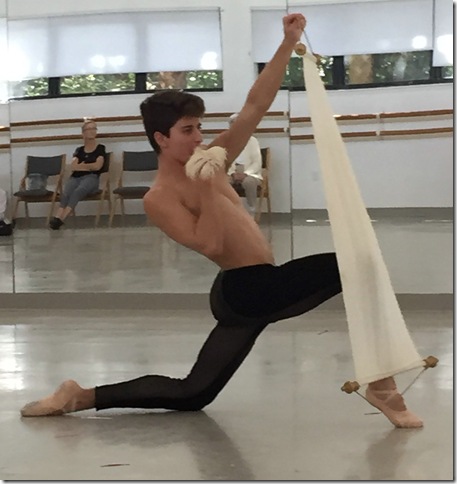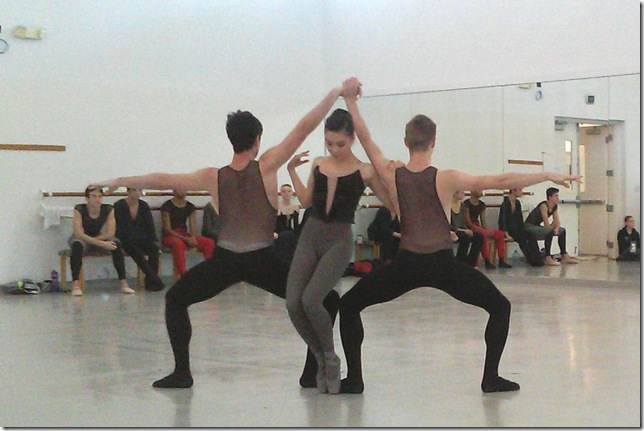In a room on the Harid Conservatory campus off Potomac Road in western Boca Raton, aspirant young professional dancers were working late last week to bring a contemporary ballet to life.
As faculty members Victoria Schneider and Meelis Pakri, music coordinator Michael Lazzaro and the dance school’s director, Gordon Wright, watched intently, the Harid students ran though the five sections of Mark Godden’s Miroirs, set to the Maurice Ravel piano suite of the same name from 1904.
As each of the performers finished their work, they did so to applause from the other dancers watching the rehearsal, a sign of respect but also of the collegiality that the school has taken pride in since its founding 28 years ago.
“I’m very grateful to be working at Harid, which is in a very unique situation. We’re talent-based, not driven by tuition income, because we’re tuition-free. That means we can recruit the best kids we can find, identify them and attract them to the school,” said Wright, 61, a Canadian-born arts administrator who danced with the Royal Winnipeg Ballet and has led the Harid Conservatory since 1992.
“I tell parents that this is a school for those kids who need to dance, in their hearts and in their souls, and who demonstrate the ability, or what we call the potential for professional accomplishment,” he said.
Beginning Friday, Harid presents its last program of the school year, which in addition to Godden’s Miroirs will feature another contemporary ballet, Martin Fredmann’s A Little Love, set to five recordings by the great American singer and activist Nina Simone. The program is rounded out by dances from two classical ballets choreographed by Marius Petipa: Paquita (to music by Ludwig Minkus), and The Sleeping Beauty (Tchaikovsky).
All 32 students at the school will be taking part in the recital, which will be performed three times at Spanish River High School’s Countess de Hoernle Theater, on Friday night and Saturday and Sunday afternoon. “Every time we do shows, we want everybody on stage,” Wright said.
Godden, a Montreal-based choreographer, has been coming to Harid to create new ballets with the students for more than 20 years. But this time, he wanted to revive a work of his from the early 1990s at the Winnipeg troupe, one that featured a solo turn from Alexei Ratmansky, then a principal dancer and now a major choreographer who currently is artist-in-residence at American Ballet Theatre (his Symphonic Dances, set to Rachmaninov’s late-career orchestral work, had its world premiere in 2012 at Miami City Ballet).
“(‘Miroirs’ is) not a brand-new piece, but of course it’s still relevant. The movement is not dated in any way,” Wright said. “Interestingly, it features more of our older students, but there were a couple younger kids that caught his eye and that he pushed, so it’s been a neat experience for them.”
Harid is a classical ballet school that teaches the Russian tradition, but Wright said it’s vital for students to learn contemporary movement as well.
“There are few purely classical companies anymore, so the kids have to be really versatile,” he said, and working with Godden and his style of movement aids them in getting there. “It just helps them learn how to adapt to choreographic and stylistic differences … That’s what’s going to help them stand out in a company. We just want to fill their toolkit with all the things that are going to help them be successful.”
Fredmann’s A Little Love, created for the Colorado Ballet, features three couples.
“We were looking for something that would offer the kids dancing together … in contemporary partnering, beyond the classical partnering, and something we felt was challenging but doable,” Wright said. Pakri, former principal dancer and ballet master at Colorado Ballet, knew the piece well and agreed to set it for the program.
“In terms of repertoire, with a school you have to look for pieces that will be interesting to the public but also challenge the kids at different age levels,” Wright said.
From Paquita, the story of a Gypsy girl who turns out to be an aristocrat by birth, the Harid troupe will perform the Adagio and the pas de trois, plus its variations. And from Sleeping Beauty, the dancers will perform the “Garland Waltz” from Act I, set to one of Tchaikovsky’s most famous melodies. Staging the waltz also has a specific pedagogic purpose.
“Vicki suggested it because she teaches Level I, the younger students, and it was a nice opportunity to get the younger students into a situation where they can do some corps work, they’re on pointe … and the Level 1 boys can do some partnering,” he said. “It was selected to address the needs of our younger students.”
Harid is a professional high school, and its students take academic courses through Florida Virtual School as well as study dance topics on campus. It has produced an impressive number of dancers for major companies in the United States, Canada and around the world, as well as students who have gone on to achievements in other fields such as engineering, medicine and the media.
Dance is not immune to the general handwringing over the state of the performing arts today, a perennial discussion that seems to continue no matter what the economic situation is. But Wright acknowledges that there are “huge issues” presenters and performers need to address in a time of rapid technological and societal change.
“Technology is changing, people’s attention spans are changing, so there’s some really significant big questions about performing arts out there,” he said. “But I personally still love ballet, and I think it’s valid, and I love to see it on the stage rather than on video or live streaming.”
The Harid Conservatory spring program will be presented at 7:30 p.m. Friday, 3 p.m. Saturday and 3 p.m. Sunday at Spanish River High School in Boca Raton. Tickets are $25-$30. Call 997-2677 or visit www.harid.edu.


